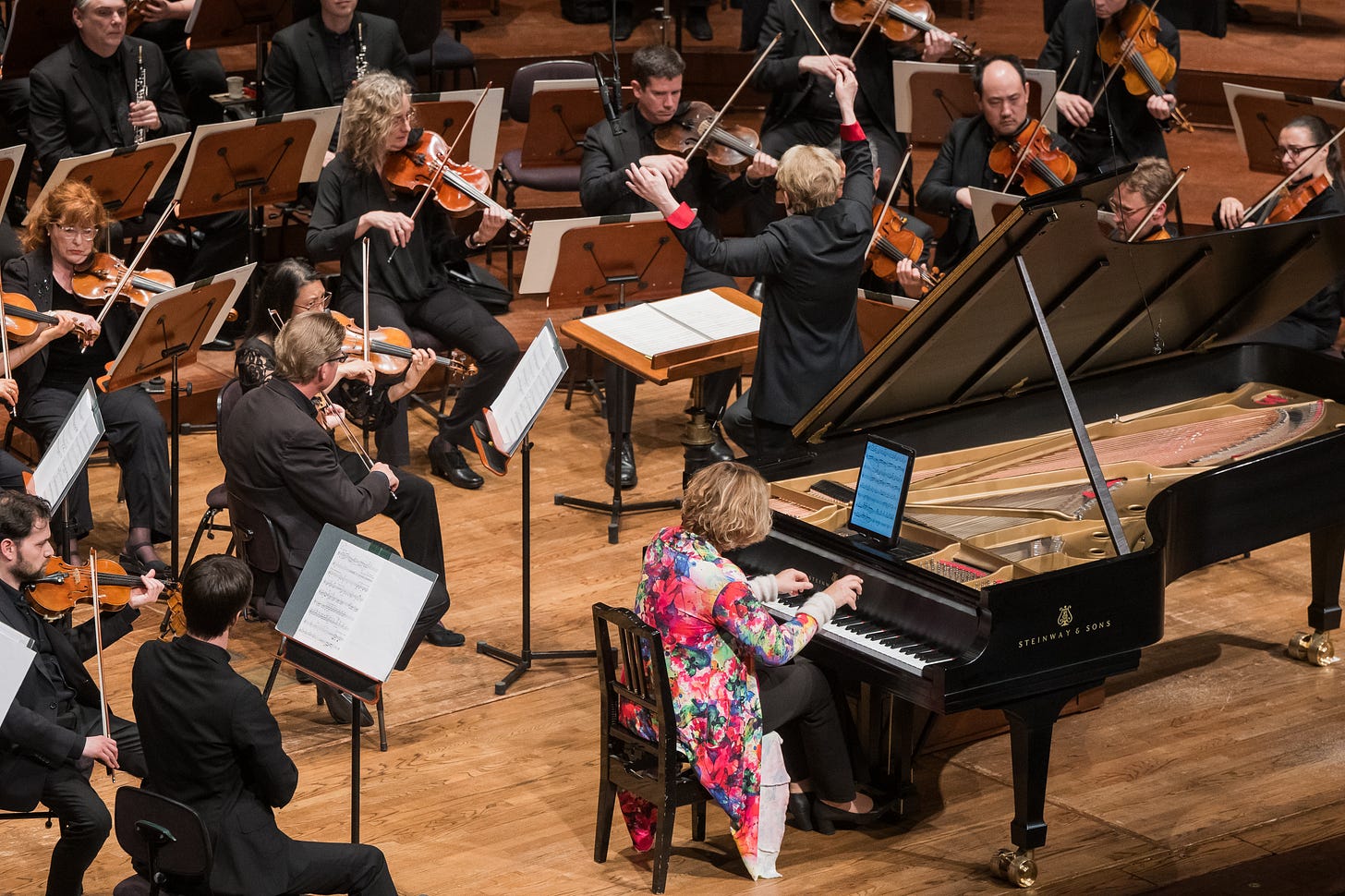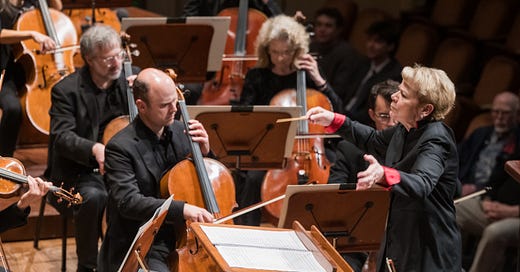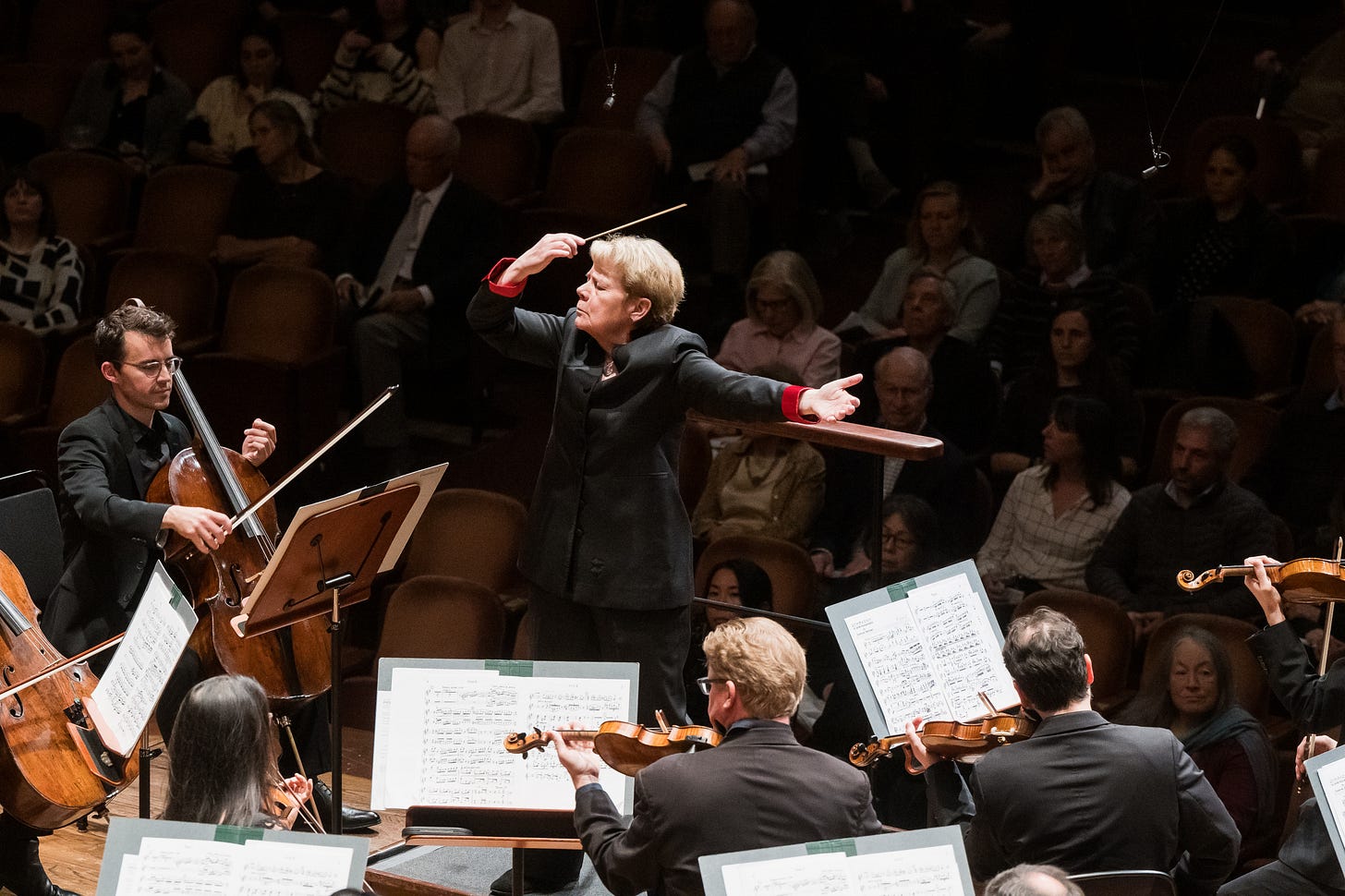Made in Americas
A program of orchestral music from North and South America brought up political contradictions
Guest conductor Marin Alsop’s program with the San Francisco Symphony, titled “Music of the Americas,” was planned and announced long before the politics of this nation and its neighbors had become so thoroughly shot through with evil and injustice. So there was a bit of a time-capsule quality to Thursday’s excellent performance in Davies Symphony Hall. Remember when celebrating the cultural situation of America (North and South) seemed relatively uncomplicated? it said. Yeah. Good times.
I felt this most keenly during the brief, thrilling moments of Aaron Copland’s Fanfare for the Common Man, which remains for me the great musical expression of all that’s finest in the American political psyche — the sort of fearless, unabashed commitment to simple liberal humanism that has all but vanished from the landscape.
But of course any variety of dewy-eyed idealism — yes, even the Copland — always involves a fair bit of self-delusion and cherry-picking. As if to underscore this point, Alsop programmed Gabriela Montero’s dazzling Piano Concerto No. 1, Latin, which featured the composer as soloist. This was intended as a nuanced portrait of Venezuela, Montero’s homeland, and in remarks from the stage, she talked about how the breezy stereotypes of Latin American life — the music, the dancing, the social freedoms — can make it easier to suppress or overlook the culture’s darker strains. Montero announced her intention to fuse the two in a kind of musical “chiaroscuro.” Intriguingly, she was a little vague about exactly where the shadows lurked, citing “witchcraft” but saying nothing explicit about political corruption or autocracy.
That quibble aside, though, this three-movement showpiece, written in 2016, emerged as a knockout piece of virtuosity, both compositionally and as a vehicle for Montero’s ferocious keyboard skills. The fast outer movements are built on dance rhythms — a mambo in the opening, a brisk 6/8 jig for the finale marked Allegro venezolano — with a slow, beautifully shaped rhapsody as the middle movement. The demands on the soloist are profound, yet Montero made it all look easy (and as if listeners weren’t already sufficiently impressed, she followed up with an encore consisting of an extended improvisation on a theme supplied by an audience member). Perhaps most striking, though, is the extent to which Montero makes good on her self-described mission to transcend the cliches of Latin dance music. You’re listening along, enjoying the rhythmic grooves and the pop-tinged harmonies, when suddenly there’s a grim undercurrent and you think, “OK wait, how long has that been going on?” It’s a bit of sleight-of-hand every bit as dexterous as Montero’s pianism itself.

The remainder of the program tended to shy away from internal contradictions. Antrópolis, a buoyant catalog of Latin dance strains by the Mexican composer Gabriela Ortiz, led off the program in a powerful rendition captained by timpanist Ed Stephan. For the second half, Alsop and the orchestra headed north, pairing Copland’s fanfare with the first of Joan Tower’s answering compositions “Fanfare for the Uncommon Woman,” and concluding with Samuel Barber’s callow but richly imagined Symphony No. 1, which drew magnificent oboe solos from the Symphony’s great English hornist Russ de Luna.
Astonishingly, this was Alsop’s first time leading the Symphony in a subscription program, even though she was a fixture on the Bay Area musical landscape for decades during her time as artistic director of the Cabrillo Festival of Contemporary Music in Santa Cruz. This kind of programming — music by women, by Latin American composers, even by Barber — was precisely her stock-in-trade during her Cabrillo years, and it’s exactly the kind of thing that has been conspicuously absent from the Symphony’s programming during the same period. It turns out there’s plenty of imaginative music still to be discovered by orchestra patrons; it’s just a matter of bringing in conductors who know where to find it.
Elsewhere:
Michael Zwiebach, San Francisco Chronicle/SFCV: “It’s hard to imagine Alsop, who seems to have the energy of 10 people, not inspiring an orchestra, and the San Francisco Symphony was on its mettle under her direction. This was a debut too long delayed, but welcome nonetheless.”
Hiatus
This marks my last column for a few weeks, as my wife and I, together with friends, revive some travel plans that were originally hatched for April 2020. I’m particularly sorry to miss the San Francisco Symphony’s April 26 celebration of Michael Tilson Thomas’ 80th birthday — an event that was added to the calendar after our travel itinerary was already in place — as well as The English Concert’s Giulio Cesare on April 27 and Giancarlo Guerrero’s May 2-3 guest appearance with the Symphony. On the other hand, I’ve got operatic and orchestral experiences lined up during vacation, which I’ll say more about on my return.
Cryptic clue of the week
From Out of Left Field #263 by Henri Picciotto and me, sent to subscribers last Thursday:
Part of a boat, or in Quebec, part of a gun (9)
Last week’s clue:
Levy and I get a cab (4)
Solution: TAXI
Levy: TAX
I: I
a cab: definition
Coming up
• Earhart Trio: The ensemble of violinist Kate Stenberg, cellist Mary Artmann and pianist Kumiko Uyeda have assembled a full and impressively varied program of chamber works under the rubric “Crossing Boundaries,” drawing on music from three continents. The lineup includes trios, both familiar and lesser-known, by composers Bent Sørensen, Dmitri Shostakovich, Astor Piazzolla, Franz Schubert, and Lera Auerbach. April 18, Center for New Music. www.centerfornewmusic.com.
• Zorro: Zorro began life in the pages of pulp fiction, and soon found a place in the worlds of radio, film, and television. Now the masked vigilante comes to the operatic stage in an opera by Bay Area composer Hector Armienta, featuring a score shot through with the sounds of mariachi and flamenco. The Opera San José production, led by conductor Jorge Parodi and directed by David Radamés, features tenor Xavier Prado in the title role. April 19-May 4, California Theatre, San Jose. www.operasj.org.







I feel exacly the same way about Copland. Brash, all American, optimistic- now i feel like weeping when i hear it. Seems like historic music for a country that no longer exists - or at best is fighting for its last breath. Have a wonderful vacation.
I've enjoyed the intriguing years with Salonen, bringing Marin Alsop as an example. I felt a stab of dread when I looked through the programming for the next season which seems dull. I'm betwixt & between about how to react to the Board's ridiculous positions that provoked chorus and orchestra members to leaflet. I have full sympathy w the artists.
So what is one to do??
I feel like boycotting the next season. But I don't want to leave the musicians and singers high & dry without support or an audience. I wonder if you could give us some discussion on these points.
Thank you, --Pepi